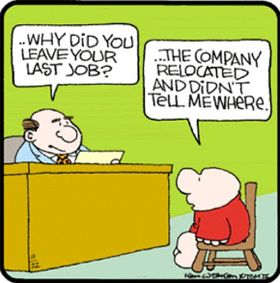It’s Not the End of the World!

The Vignette Strategy
Vignettes, or brief descriptions, should be used in every interview to describe knowledge, accomplishments, and experiences. A vignette should convince interviewers that you know what you are talking about and should replace the simple yes or no response to interview questions.
Résumés are the first place vignettes should appear, interview preparation is where a career of vignettes should be summarized, and interviews are where vignettes should be presented. The format of these mini-stories should include a company problem, action taken by you, and the outcome that benefited a previous employer. The vignettes, like the example that follows, should take between one and three minutes to recount. Interviewers may ask you to elaborate on certain aspects of the vignette or move on to another question. The company was poised to establish a new businessventure and customers were confused about the directionthe company was taking. (problem) I organized ateam comprised of internal experts and line managersfrom the new venture. I then led the team in definingand communicating the new venture’s mission andstrategy to existing and potential customers. (actiontaken) The new venture exceeded revenue projectionsin the first three months of business because of an informedcustomer base and an effective strategy. (resultingbenefit)
Vignettes should be organized in a logical order, perhaps by position requirement, to validate your qualifications for the job to be filled.
For each required strength and skill, prepare a few factual vignettes based on your experiences and achievements. Sequence the vignettes from the most recent to the oldest without using dates. Document the vignettes to be delivered as arrows in a quiver during the interview. These mini-narratives should convince interviewers that you have done what the job requires and have the ability to perform these same tasks again. They also serve to create a perception that you will have a short learning curve. It is essential to exhibit a sense of accomplishment, pride, and satisfaction when presenting each vignette to an interviewer. Recent graduates will not have years of experience to create many vignettes. Often, just a few very relevant vignettes can impress interviewers. There are surprisingly many sources from which recent graduates can prepare vignettes, including individual accomplishments and skills obtained in part-time jobs, volunteer work, or internships.
Responsibility as the captain of a varsity team can certainly produce leadership stories. Participating in an extracurricular activity, traveling for a semester abroad, or volunteering for a mentoring program are great sources for vignettes. Courses taken and projects completed, such as a complex financial spreadsheet, an engineering design, or a visual basic program are excellent examples. The key to being a top candidate is in the delivery—be focused, energetic, and exhibit passion.
Vignette Preparation and Examples
In addition to preparing vignettes relating to your functional skills and accomplishments, consider other qualities you can offer a prospective employer. Interview preparation should include vignettes that demonstrate your leadership, teamwork, supervision of a difficult employee, and a difficult project completed. Vignettes should be typed and taken with you to the interview. Prepare the list on white bond 81⁄2- by 11-inch paper and insert the paper into a notepad as the second page, hidden from the interviewer’s view.
The following are abbreviated samples of vignettes organized by functional discipline. They are brief, focused, and should take less than two minutes to present.
Operations
- Decision-support tools were absent in a Fortune 500 company. I utilized operations research techniques to build and implement decision-support systems. I developed an inventory control model and produced annual savings of $20 million.
- Quality review procedures were nonexistent in a complex business plan for a new venture. I initiated and completed the quality review of processes and procedures based on ISO 9000 quality principles and oversaw implementation of its recommendations. The board of directors subsequently approved the plan.
- The cost of travel services provided by an independent travel agent was prohibitive. I evaluated the legal implication of terminating the agreement and assessed the feasibility of creating an internal travel function. I successfully negotiated a release from the contract, developed an internal travel function, and saved $1 million annually.
Business Development
- The growth of a fledgling business required alliance partners to reduce costs and increase revenue. I initiated discussions with fifteen potential partners, evaluated their business proposals, and entered into partnership agreements with four organizations. The company experienced significant growth.
Financial
- Expense and capital budgets were not controlled and there was a risk of exceeding authorized limits. I instituted expense reporting and control procedures for a $30 million budget and documented the objectives and benefits of each project. This action increased management confidence and introduced effective controls over spending.
- The company had cash flow problems and was soon to have problems meeting payroll. I evaluated and negotiated banking relationships, gave numerous presentations, and obtained a $15 million line of credit.
Marketing
- A significant rollout for a major product was planned, but emphasis was placed on technical aspects and less on marketing requirements. I determined customer needs, developed and implemented marketing recommendations, and introduced the product at a well-publicized media event. The rollout was successful and customer acceptance was excellent.
- The decreasing number of subscribers was causing a decline in revenues, and something was needed to keep the publication solvent. I executed marketing programs, which integrated print, TV, direct mail, and cross-promotion opportunities. This initiative increased revenues by 15%
Information Technology
- The growth in the number of worldwide offices led to a confusing array of incompatible software and hardware configurations. I obtained the confidence of worldwide management and developed a global information technology plan with standard applications and systems. I then obtained funding and implemented the plan during a two-year period, which improved efficiencies and generated additional revenues.
- The information technology (IT) department’s systems and databases were unreliable, the systems staff was not experienced, and costs were out of control. I led a reorganization of the IT department, reducing the number of locations from seven to five and the number of IT employees from 350 to 225. I developed new procedures to optimize performance, reduce the workforce, and control project quality. Resulting savings was in excess of $8 million annually.
- The contract negotiation process was too lengthy and disadvantageous to the negotiating team. I led a systems project to design and develop a contract management system used by chief negotiators and lawyers when negotiating large contracts with business customers. Implementation of the system resulted in reducing the negotiating time by 75 percent and I was given the annual company productivity award.

Links to Related Articles:
Perfecting Your Job Hunt - Part 1
Other Useful Links:
Six Must Ask Interview Questions
Interview Fashions and Grooming Tips
